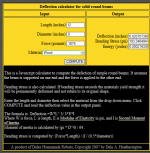There are several high speed pics of the cue tip being compressed against a CB but the CB does not move instantaneously but. eventually when the tip is compressed enough, the CB starts to roll or move forward.
To counter this visual, it was proffered than one should touch the CB with the tip very slowly until the CB starts to rotate forward (won't slide on the cloth) in this case and to measure how much the tip compressed - immeasurable. What does this prove?
Here is a comparable example that without equations illustrates why this was not a fair comparison:
"Weights on Strings
Large weights are each suspended by a single strand of breakable string. A strand of this string is also attached to the bottom of each weight. The weights are not attached to each other in any way. Students are asked which string will break first: the one above the weights, or the one below, when the strings below the weights are pulled. Which one actually breaks depends on how the string is pulled. If the string is pulled very fast, the string below the weight breaks first every time, while if the string is pulled slowly, it breaks above the weight every time.
This is because of the inertia of the weights. A quick pull does not give the weight a chance to move. In order for the string above the weight to get tighter, the weight must move down a bit. If the pull is fast enough, it gets much tighter below the weight than above, and that is where it will break. If the string is pulled slowly, it gets tighter above the weight, for the weight does have a chance to move, and the string above has to support the weight and resist the tug."
.
http://www2.cose.isu.edu/~shropshi/fmdesc.htm
Hitting the CB with speed to impact and overcome its mass (inertia) to send it forward or even slide is different than slowly pushing on it where the mass of the CB is born by the slate.
Inertia defined by Wiki.

Newton actually attributed the term "inertia" to mean "the innate force possessed by an object which resists changes in motion"; thus Newton defined "inertia" to mean the cause of the phenomenon, rather than the phenomenon itself. However, Newton's original ideas of "innate resistive force" were ultimately problematic for a variety of reasons, and thus most physicists no longer think in these terms. As no alternate mechanism has been readily accepted, and it is now generally accepted that there may not be one which we can know, the term "inertia" has come to mean simply the phenomenon itself, rather than any inherent mechanism. Thus, ultimately, "inertia" in modern classical physics has come to be a name for the same phenomenon described by Newton's First Law of Motion, and the two concepts are now considered to be equivalent

Be well


